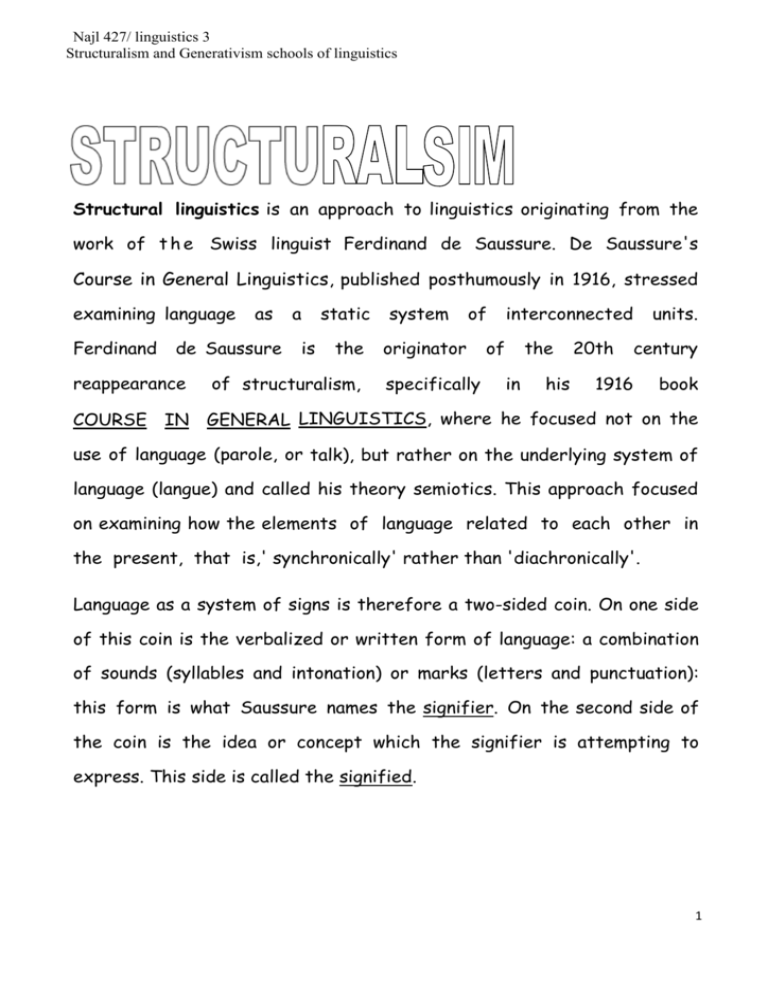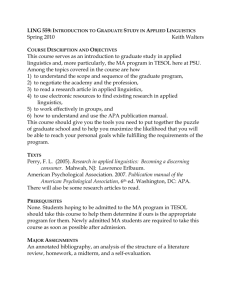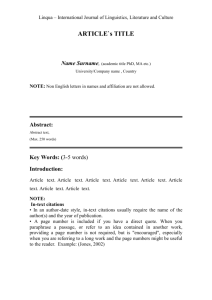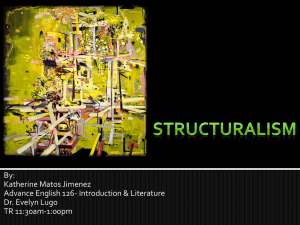File
advertisement

Najl 427/ linguistics 3 Structuralism and Generativism schools of linguistics Structural linguistics is an approach to linguistics originating from the work of t h e Swiss linguist Ferdinand de Saussure. De Saussure's Course in General Linguistics, published posthumously in 1916, stressed examining language Ferdinand as de Saussure reappearance a is static the of structuralism, system of originator specifically interconnected of the in his 20th units. century 1916 book COURSE IN GENERAL LINGUISTICS, where he focused not on the use of language (parole, or talk), but rather on the underlying system of language (langue) and called his theory semiotics. This approach focused on examining how the elements of language related to each other in the present, that is,' synchronically' rather than 'diachronically'. Language as a system of signs is therefore a two-sided coin. On one side of this coin is the verbalized or written form of language: a combination of sounds (syllables and intonation) or marks (letters and punctuation): this form is what Saussure names the signifier. On the second side of the coin is the idea or concept which the signifier is attempting to express. This side is called the signified. 1 Najl 427/ linguistics 3 Structuralism and Generativism schools of linguistics The arbitrary nature of the sign--The sign is arbitrary because "the bond between the signifier and the signified arbitrary." He argued that linguistic signs were composed of two parts, a signifier (the sound pattern of a word, either in mental projection - as when we silently recite lines from a poem to ourselves - or in actual, physical realization as part of a speech act) and a signified (the concept or meaning of the word). Leonard Bloomfield (April 1, 1887 – April 18, 1949) was an American linguist who led the development of structural linguistics in the United States during the 1930s and the 1940s. In the writing of Language, Bloomfield claimed that linguistic phenomena could properly and successfully be studied when isolated from their nonlinguistic environment. Bloomfield is known for applying the principles of behaviorist psychology to linguistics, defining "the meaning of a linguistic form as the situation in which the speaker utters it, and the response it calls forth in the hearer." 2 Najl 427/ linguistics 3 Structuralism and Generativism schools of linguistics Generative linguistics is a school of thought within linguistics that makes use of the concept of generative grammar. The term 'Generative Grammar' is given by Noam Chomsky - The grammar will have a finite (limited) number of rules, but will be capable of generating an infinite number of well-formed structures. "Generativism" is a movement or trend which follows the concept of 'Generative Grammar". Naom Chomsky (December 7, 1928), The Chomskyan approach towards syntax, often termed generative grammar, studies grammar as a body of knowledge possessed by language users. Noam Chomsky asserts that language is innate.. he proposed his famous theories on language acquisition. According to Chomsky, language is one characteristic that is unique to humans among all other living beings. Chomsky’s theories have made it easier to understand the evolution and development of the languages. Noam Chomsky claimed that the mechanism of the language acquisition is derived from the innate processes. Innate is something we were already born with. 3 Najl 427/ linguistics 3 Structuralism and Generativism schools of linguistics 4 Najl 427/ linguistics 3 Structuralism and Generativism schools of linguistics 5 Najl 427/ linguistics 3 Structuralism and Generativism schools of linguistics 6 Najl 427/ linguistics 3 Structuralism and Generativism schools of linguistics 7 Najl 427/ linguistics 3 Structuralism and Generativism schools of linguistics







